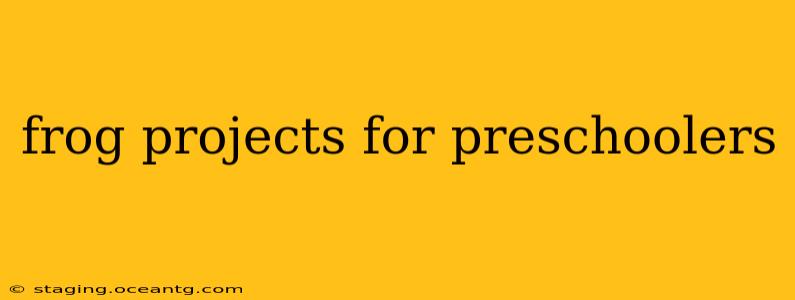Preschoolers are naturally curious and love hands-on activities. Frog-themed projects offer a fantastic opportunity to combine fun with learning, exploring science, art, and literacy all at once. These projects cater to different developmental stages and learning styles, ensuring every preschooler can participate and enjoy. Let's dive into some ribbiting ideas!
What are some easy frog crafts for preschoolers?
Easy frog crafts for preschoolers should focus on simple techniques and readily available materials. Paper plate frogs, for instance, are a classic. Simply cut a paper plate in half, paint it green, add googly eyes, and cut out some small circles for the frog's legs. Another simple option is using construction paper to create a frog shape, then letting children decorate it with markers, crayons, or paint. You can even explore different textures by adding cotton balls for a fuzzy frog or using tissue paper for a more vibrant look. Remember to focus on the process, encouraging creativity and self-expression, rather than achieving a perfect replica.
How can I make a frog life cycle project with preschoolers?
Creating a frog life cycle project is a great way to introduce preschoolers to the fascinating transformation of a frog. You can use various materials, including pictures, drawings, or even small figurines. One approach is to sequence pictures of each stage—egg, tadpole, tadpole with legs, froglet, and adult frog—on a large piece of paper or cardboard. Children can help arrange the pictures in the correct order, reinforcing their understanding of the life cycle. Alternatively, you can create individual cards for each stage, allowing children to manipulate and reorder them as they learn. Adding simple labels to each stage further enhances vocabulary development.
What kind of frog activities are good for preschoolers?
Beyond crafts, several engaging activities can reinforce learning about frogs. A simple sensory bin filled with green beans, pasta, or even small toys can provide a tactile experience, letting children explore textures associated with a frog's environment. Reading age-appropriate books about frogs introduces new vocabulary and sparks imaginative play. You can also incorporate dramatic play, encouraging children to act out the life cycle of a frog or create their own froggy scenarios. Singing songs about frogs adds a musical element, and outdoor nature walks help children observe frogs (or their habitats) in their natural environment, making the learning experience even more memorable.
What are some fun frog facts for preschool?
Sharing interesting frog facts with preschoolers makes learning fun and engaging. For instance, you can discuss how frogs use their long, sticky tongues to catch insects, or explain how their skin helps them breathe. You can talk about the different colors and sizes of frogs found around the world, highlighting their incredible diversity. Keep the information simple and relatable, using age-appropriate language and visuals to enhance understanding. Don't forget to emphasize the importance of protecting frogs and their habitats.
What are some good books about frogs for preschool?
Many excellent children's books explore the world of frogs. These stories often combine engaging narratives with beautiful illustrations, captivating young minds and making learning enjoyable. Look for books that offer simple text and vibrant visuals to suit the attention span and comprehension levels of preschoolers. Check your local library or bookstore for options—librarians can also be great resources in finding age-appropriate books on specific topics.
By incorporating these creative and educational frog projects, preschoolers can learn about these fascinating amphibians while having a lot of fun! Remember to adapt the projects to your students' specific needs and interests, making the learning experience both enriching and enjoyable.
